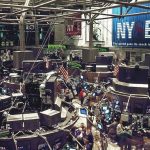It is a truism in investing that if you want to generate higher returns, you need to take more risk. But that truism is a myth, according to Ed Easterling, a contributor to the book, “Just One Thing: Twelve of the World’s Best Investors Reveal the One Strategy You Can’t Overlook.”
Easterling is one of 12 investors invited to contribute by the book’s editor, John Mauldin. The Oregon-based investor and writer is the founder and president of Crestmont Holdings, an investment management and research firm that “publishes provocative research on the financial markets.” Easterling has more than 30 years of alternative investing experience. He is the author of “Unexpected Returns: Understanding Secular Stock Market Cycles” and “Probable Outcomes: Secular Stock Market Insights.” And he has taught courses on alternative investments and hedge funds at the Cox School of Business in Dallas.
The idea that you can get better returns from more risk is flawed. Easterling argued the implication of that idea is risk can somehow be coupled with investment capital to create returns.
Reality, however, tells us that risk is “a condition that drives investors to demand compensation and protection.” While higher returns are associated with higher risks, that is much different than the idea that risk drives return.
Risk, argued Easterling, is the uncertainty of a loss; that you will lose money on an investment. Stocks, being inherently riskier than bonds, generally earn higher returns—in the long run. The degree of risk among individual stocks varies a great deal, however, and stocks are most risky when their valuations are high. He wrote:
“The expected returns for highly priced stocks can be very low; they may even remain negative for years. In these circumstances, stocks are priced at levels that may provide a lower return than bonds. An investor who adopts the traditional logic that higher risk leads to higher returns and increases his stock allocation at a time of high stock valuations may be lowering his expected return rather than increasing it. The investor is simultaneously increasing his risk and lowering his expected return for years into the future.”
He went to make a case that “risk is not a knob to be turned for greater returns,” and that modern portfolio theories have become inverted because investors began to think that higher returns would flow out of higher risk.
The amount of return an investor expects for taking on a specific level of risk is known as “expected returns.” The phrase came from Harry Markowitz in his “Modern Portfolio Theory,” in the Journal of Finance in 1952. In Easterling’s words: “And so, expected returns, other than yields from risk-free Treasury bills, include a risk premium—a gross yield before any losses.”
If we discuss risk in quantitative terms, then we also need to ask how it should be measured. The author reported that “There are many ways to assess and measure risk, including methods for quantifying the probability or magnitude of a loss. Investors use these measures to determine the likelihood of losing money on an investment and to estimate how much they could lose if the investment fails to perform as expected.”
He went on to point out that two broad types of risks are associated with investment choices, risks from the stock market as a whole (systemic risk) and risks from individual securities (residual risk).
Regarding probabilities, Easterling pointed out they are only true if statistically valid. Without evidence, “a probability is little more than an educated guess.” In particular, he warned about using probabilities without knowing the risk and return profiles involved.
For example, you have $12,000 to invest and a choice of two investments. One is an oil well with a 25% chance of success and a payoff of 10 times your investment if successful. The other is a portfolio of a dozen ventures and you invest $1,000 in each of them; you expect to lose $9,000 on nine losing ventures, but $10,000 each on the three ventures that turn out to be successful ($30,000 in total). In each case, your expected return is 250% from very different scenarios.
Short-term and long-term considerations also come into play when assessing risk. In the short term, break-even will work as a proxy for evaluating risk. But it will not work the same way over the long term. That’s because two factors emerge over the longer haul: inflation and liabilities.
Looking first at inflation, its effects are minimal in the short term, but it does matter in the longer run because losses from inflation will compound over time. Using the historic inflation average of 3.5% (as of 2006), a product that costs $1 will cost $1.41 just 10 years later. That represents a loss of 30% in your purchasing power.
Turning to liabilities that grow over a longer term, Easterling observed that institutions such as pension plans and endowments have liabilities they need to fund. Individuals are also affected by the requirement to meet retirement goals and family responsibilities.
From there, he was able to put risk in a new light:
“For the purpose of assessing portfolio risk, it is clear that a measure and assessment other than break-even is necessary. Rather than simply recovering the principal, investors should assess the probability of achieving the required or expected rate of return. Risk, therefore, represents the uncertainty of a shortfall in achieving the projected liability.”
Then there is the issue of volatility: “The greater the volatility of the returns, the greater the drop in the compounded return”. He added:
“Negative numbers and the dispersion of returns around the average are mathematical mites. Each has a significant effect on realized returns. By understanding their impact, investors can appreciate the benefits of reducing volatility and increasing the consistency of investment returns. Investors can then realize higher compounded returns and experience a more enjoyable and less stressful investment ride.”
Conclusion
Easterling began his article in “Just One Thing” with the title, “Risk Is Not a Knob”, implying that taking on greater risk does not necessarily lead to higher returns. In fact, the causality runs in the other direction; investors demand higher returns for shouldering greater risks.
Although inflation is no longer as serious as it was in previous decades, it can still be a factor in the long run. Consider compounded inflation of just 2% over a 35-year retirement—that’s going to make it tougher and tougher to get by on your retirement income.
Finally, I was struck by the role of negative numbers and high volatility in seriously reducing the compounding effect in the long term.
Read more here:
Not a Premium Member of GuruFocus? Sign up for a free 7-day trial here.
About the author:
Robert Abbott
Robert F. Abbott has been investing his family’s accounts since 1995 and in 2010 added options — mainly covered calls and collars with long stocks.
He is a freelance writer, and his projects include a website that provides information for new and intermediate-level mutual fund investors (whatisamutualfund.com).
As a writer and publisher, Abbott also explores how the middle class has come to own big business through pension funds and mutual funds, what management guru Peter Drucker called the “unseen revolution.”
Source: impact investing




